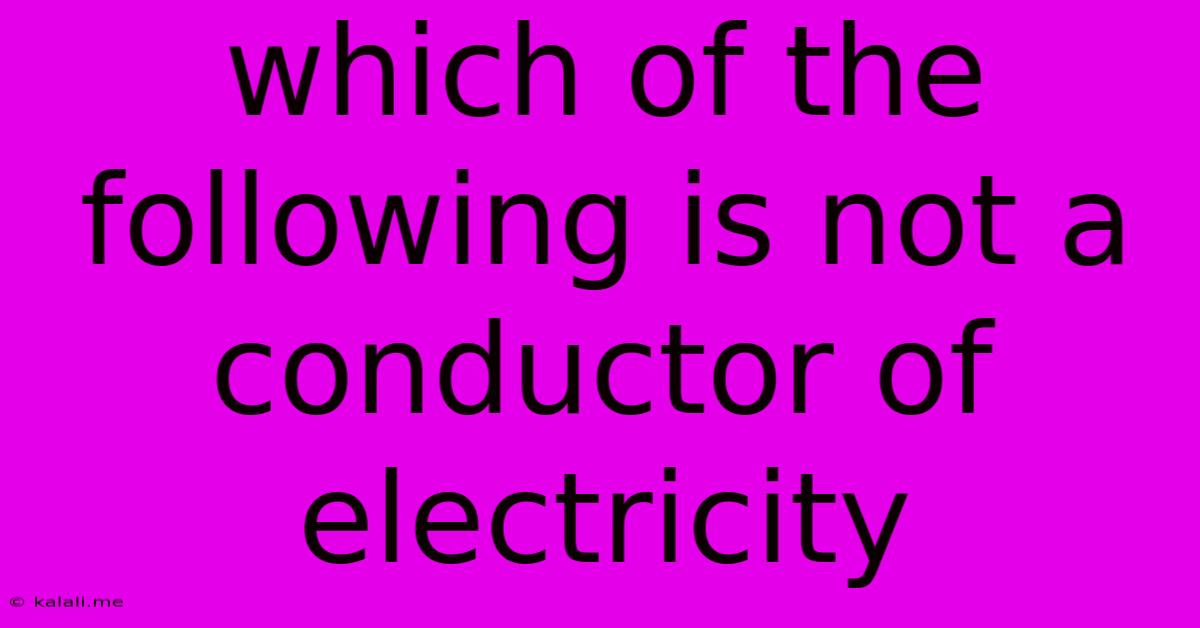Which Of The Following Is Not A Conductor Of Electricity
Kalali
Jun 12, 2025 · 3 min read

Table of Contents
Which of the Following is NOT a Conductor of Electricity? Understanding Conductivity
This article will explore the concept of electrical conductivity, identifying materials that readily allow the flow of electric current and those that resist it. We'll clarify why certain materials are excellent conductors while others act as insulators, a crucial concept in electrical engineering and everyday life. Understanding the difference is essential for safety and efficient use of electricity.
What is Electrical Conductivity?
Electrical conductivity refers to a material's ability to allow the flow of electric charge. This flow is facilitated by the movement of electrons, the negatively charged particles within atoms. Materials with high conductivity have loosely bound electrons that can easily move when an electric field is applied. Conversely, materials with low conductivity, or high resistivity, hold their electrons tightly, hindering the flow of charge.
Conductors vs. Insulators:
The key distinction lies in the atomic structure and electron behavior:
-
Conductors: These materials possess a large number of free electrons. Metals like copper, silver, gold, and aluminum are prime examples. The electrons in their outer shells are weakly bound, allowing for easy movement and facilitating current flow. Other materials, such as graphite and saltwater, also exhibit conductivity, although generally less efficiently than metals.
-
Insulators: Insulators, on the other hand, have tightly bound electrons. These electrons are not easily freed to move, creating resistance to the flow of electric current. Common insulators include rubber, plastic, glass, wood, and dry air. These materials are vital in electrical systems to prevent short circuits and ensure safety.
Identifying Non-Conductors (Insulators) from a List:
When given a list of materials, identifying the non-conductor requires understanding the properties discussed above. For example, consider this list:
- Copper wire
- Rubber band
- Gold bar
- Glass rod
- Saltwater
In this scenario, the rubber band and glass rod are the non-conductors, or insulators. Copper wire, gold bar, and saltwater are all conductors to varying degrees.
Factors Affecting Conductivity:
Several factors influence a material's conductivity:
-
Temperature: Generally, the conductivity of metals decreases with increasing temperature, while the conductivity of semiconductors increases.
-
Impurities: The presence of impurities can significantly affect conductivity, often reducing it in metals.
-
Material Structure: The crystalline structure of a material plays a role in its conductivity; imperfections can create resistance.
-
Material Type: As mentioned, the inherent atomic structure and electron configuration determine whether a material is a good conductor or insulator.
Real-world Applications:
Understanding the difference between conductors and insulators is crucial for various applications:
-
Electrical Wiring: Copper and aluminum are used extensively in electrical wiring due to their high conductivity.
-
Electrical Insulation: Insulators like rubber and plastic are used to coat wires to prevent short circuits and electric shocks.
-
Semiconductors: Materials like silicon and germanium have intermediate conductivity, making them essential components in electronic devices.
Conclusion:
Identifying which material is NOT a conductor of electricity relies on a fundamental understanding of electrical conductivity, the differences between conductors and insulators, and the factors affecting conductivity. This knowledge is fundamental to safe and efficient electrical systems and countless technological applications. By understanding the atomic properties that govern electron movement, we can effectively differentiate between conductors and insulators.
Latest Posts
Latest Posts
-
Transitive And Intransitive Verbs Exercises With Answers
Jun 13, 2025
-
What Number Is A Multiple Of 6
Jun 13, 2025
-
How Long Does It Take Earth To Complete One Rotation
Jun 13, 2025
-
Which Of The Following Came First
Jun 13, 2025
-
What Is The Lightest Element On The Periodic Table
Jun 13, 2025
Related Post
Thank you for visiting our website which covers about Which Of The Following Is Not A Conductor Of Electricity . We hope the information provided has been useful to you. Feel free to contact us if you have any questions or need further assistance. See you next time and don't miss to bookmark.